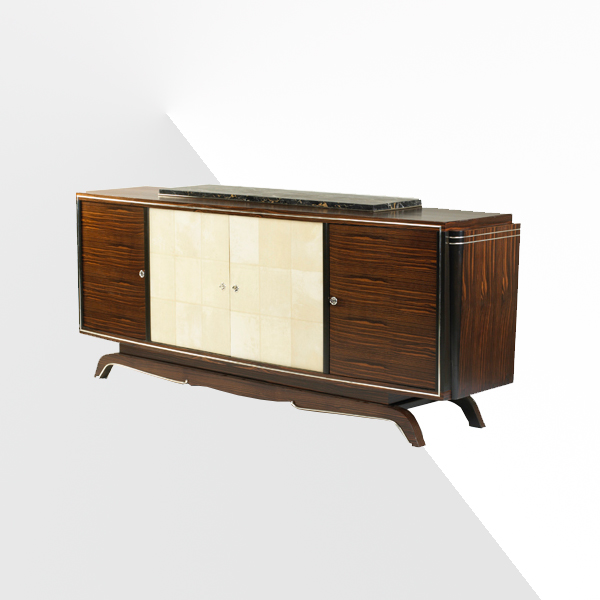[av_slideshow_full size=’no scaling’ stretch=” animation=’fade’ autoplay=’false’ interval=’5′ control_layout=’av-control-default’ src=” attachment=” attachment_size=” position=’top left’ repeat=’no-repeat’ attach=’scroll’]
[av_slide_full slide_type=’image’ id=’60266′ video=” mobile_image=” video_format=” video_ratio=” title=’Jules Leleu’ custom_title_size=’48’ custom_content_size=’18’ caption_pos=’caption_center’ link_apply=” link=’lightbox’ link_target=” button_label=” button_color=’light’ link1=’manually,http://’ link_target1=” button_label2=” button_color2=’light’ link2=’manually,http://’ link_target2=” font_color=’custom’ custom_title=’#ffffff’ custom_content=’#020202′ overlay_opacity=’0.1′ overlay_color=” overlay_pattern=” overlay_custom_pattern=”]
BY SUSAN BRANDABUR
[/av_slide_full]
[/av_slideshow_full]
[av_textblock size=” font_color=’custom’ color=’#ffffff’]
This circa-1930 Jules Leleu sideboard of macassar ebony, parchment over wood, and marble, signed on ivory plaque. Image courtesy Wright, Chicago.
[/av_textblock]
[av_section min_height=” min_height_px=’500px’ padding=’large’ shadow=’no-shadow’ bottom_border=’no-border-styling’ id=” color=’main_color’ custom_bg=’#f2f2f2′ src=” attachment=” attachment_size=” attach=’scroll’ position=’top left’ repeat=’no-repeat’ video=” video_ratio=’16:9′ overlay_opacity=’0.5′ overlay_color=” overlay_pattern=” overlay_custom_pattern=”]
[av_one_full first min_height=” vertical_alignment=’av-align-top’ space=” margin=’0px’ margin_sync=’true’ padding=’10px,20px,10px,20px’ border=’1′ border_color=’#eaeaea’ radius=’1px’ radius_sync=’true’ background_color=’#ffffff’ src=” attachment=” attachment_size=” background_position=’top left’ background_repeat=’no-repeat’]
[av_hr class=’invisible’ height=’20’ shadow=’no-shadow’ position=’center’ custom_border=’av-border-thin’ custom_width=’50px’ custom_border_color=” custom_margin_top=’30px’ custom_margin_bottom=’30px’ icon_select=’yes’ custom_icon_color=” icon=’ue808′ font=’entypo-fontello’]
[av_textblock size=” font_color=” color=”]
Though Emile-Jacques Ruhlmann may be the father of French Art Deco, the name of another patriarchal designer, Jules Leleu, is also well known, as detailed in a 480-page monograph titled The House of Leleu: Classic French Style for a Modern World, 1920-1973, by Francoise Sirex.
[/av_textblock]
[av_hr class=’invisible’ height=’20’ shadow=’no-shadow’ position=’center’ custom_border=’av-border-thin’ custom_width=’50px’ custom_border_color=” custom_margin_top=’30px’ custom_margin_bottom=’30px’ icon_select=’yes’ custom_icon_color=” icon=’ue808′ font=’entypo-fontello’]
[av_textblock size=’16’ font_color=’custom’ color=’#686868′]
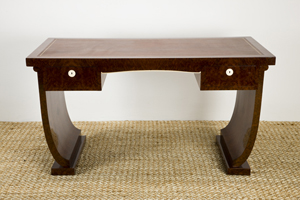
The author had worked for Leleu and, using a rented van, rescued the company’s archives when it closed in 1973.
Maison Gerard, an influential New York design gallery founded in the 1970s by Gerard Widdershoven, has been a leader in reviving the Leleu name.
“From fairly early on, the House of Leleu was not one person,” said Benoist Drut, a partner in the firm, “but an entity headed by Jules Leleu and run by several of his family members including his daughter, Paule, and sons Jean and Andre.” The autocratic Jules was a demanding presence in the business even when his interests turned to painting and sculpting in the 1940s, but he entrusted family members with significant roles, and the House of Leleu outlived him by a little more than a decade. (Jules died in 1961.)

Background
Born in 1883 in Boulogne-Sur Mer, France, Jules Leleu took over his family’s painting business in 1909 and with his brother Marcel added a cabinetmaking shop. The brothers were drafted into service in World War I in 1914. When he returned after four years in the air force, Jules focused on furniture making. The House of Leleu eventually became known for lavish private interiors and also for large-scale corporate projects, designing everything from ocean liners to embassies.
French Art Deco, with its purity of line and classical references, arrived on the heels of its flowery, free-flowing predecessor Art Nouveau. Some historians date the beginning of the movement to before the First World War, citing early examples by Ruhlmann and Eileen Gray, while others simply refer to the decade of 1920-1930 when they discuss Art Deco. The title came from the legendary 1925 Exposition Internationales des Arts Decoratifs et Industriels Modernes but it was not used contemporaneously — it’s a relatively recent term.
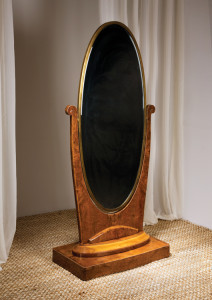
That now-legendary furniture fair, showcasing Jules Leleu, Paul Follot, Emile-Jacques Ruhlmann, Eileen Gray, and Jean Dunand among many others, was a defining moment in the public’s embrace of Art Deco, even though it came somewhat late in the movement’s trajectory. There, Leleu was awarded a prize for one of his furniture designs.
Jules Leleu was known for using superb craftsmanship and expensive materials: “warm” woods like ebony, palissander, and walnut, ivory inlays, and lavish escutcheons and other metalwork embellishments. His earlier designs can look almost indistinguishable from Ruhlmann’s.
Leleu’s private clients were wealthy, and his designs, very costly. Typically the House of Leleu (in the tradition of the decorateur ensemblier) would be commissioned to design all the appointments for an interior: tapestries, lighting fixtures, furniture, rugs, fabrics and metalwork.
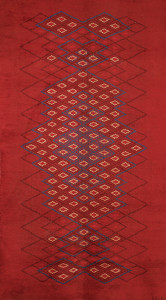
World War II
World War II changed everything. During the war years, Jules Leleu and his son Jean enlisted in the air force, while other family members, most notably, according to Benoist Drut, Paule Leleu, kept the House of Leleu in operation.
“Paule was concerned that the great craftsmen were being drafted into service and their knowledge would be lost, so she designed some very ornate pieces of furniture as teaching projects – so young apprentices could see their elders using the full range of techniques.”
Post War: Adapting to Change
When the war ended, many great family fortunes had been diminshed substantially. People who might have been Leleu’s clients had suffered dramatic losses. In a fashion characteristic of the House of Leleu throughout its existence, the family adapted. “Without sacrificing any of the superb craftsmanship for which they had become known, the House of Leleu made adjustments,” Drut said.
[/av_textblock]
[av_hr class=’invisible’ height=’50’ shadow=’no-shadow’ position=’center’ custom_border=’av-border-thin’ custom_width=’50px’ custom_border_color=” custom_margin_top=’30px’ custom_margin_bottom=’30px’ icon_select=’yes’ custom_icon_color=” icon=’ue808′ font=’entypo-fontello’]
[av_heading tag=’h3′ padding=’10’ heading=’“In every phase of the House of Leleu’s lifespan, decade by decade, you can see their ability to change with the times.”’ color=’custom-color-heading’ style=’blockquote classic-quote’ custom_font=’#020202′ size=’44’ subheading_active=” subheading_size=’15’ custom_class=”][/av_heading]
[av_hr class=’invisible’ height=’50’ shadow=’no-shadow’ position=’center’ custom_border=’av-border-thin’ custom_width=’50px’ custom_border_color=” custom_margin_top=’30px’ custom_margin_bottom=’30px’ icon_select=’yes’ custom_icon_color=” icon=’ue808′ font=’entypo-fontello’]
[av_textblock size=’16’ font_color=’custom’ color=’#686868′]
Sometimes the choices reflected both stylistic and pragmatic concerns, such as in the appearance of metal legs. They used beka lacquer (a new plastic-based formula related to Bakelite) instead of natural resin-based lacquer. Mother-of-pearl replaced ivory. And less-expensive wood veneers were used,” Drut explained.
Interestingly, those super-ornate pieces designed by Paule during the war found a ready audience among customers made newly rich by war-related commerce, according to Drut.
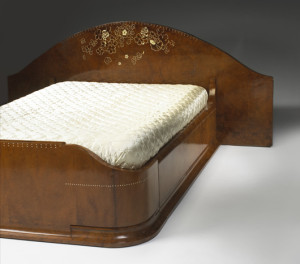
The Leleus also implemented new ways of selling their designs, creating a “diffusion” line, which, while not cheap, was more affordable than the custom-made pieces that were part of grand prewar interiors projects. Production was still small, with perhaps five to 10 editions of a given design made.
“In every phase of the House of Leleu’s lifespan, decade by decade, you can see their ability to change with the times,” Drut observed.
Benoist Drut believes Ruhlmann, who became terminally ill and died in 1933, would have adapted to changing times in much the same way, even though he was an outspoken snob about using the rarest and most expensive materials and catering only to the very wealthy. In one of Ruhlmann’s last projects, a sport-fishing club he designed in 1932, he demonstrated this willingness to shift by creating simple oak chairs with straw seats.
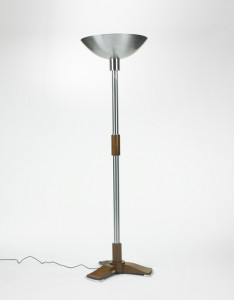
Drut experienced a rare close-up look at Leleu’s work: a Paris apartment whose 1964 interior was designed by the House of Leleu and had been left untouched after the owner, a Mr. Schmitt, died in the 1990s. Tied up in a protracted estate process, the apartment in the 16th arondissement was shrouded in dust and canvas covers when gallerists entered it.
“Mr. Schmitt was a manufacturer of colorants, and the design included some vividly colored finishes to please him,” Drut said. Maison Gerard bought the entire contents, which then comprised a 2008 Leleu exhibition at the gallery.
Resources:
Wright 20
[/av_textblock]
[/av_one_full][/av_section][av_hr class=’invisible’ height=’50’ shadow=’no-shadow’ position=’center’ custom_border=’av-border-thin’ custom_width=’50px’ custom_border_color=” custom_margin_top=’30px’ custom_margin_bottom=’30px’ icon_select=’yes’ custom_icon_color=” icon=’ue808′ font=’entypo-fontello’]
[av_one_fifth first min_height=” vertical_alignment=” space=” custom_margin=” margin=’0px’ padding=’0px’ border=” border_color=” radius=’0px’ background_color=” src=” background_position=’top left’ background_repeat=’no-repeat’][/av_one_fifth]
[av_four_fifth min_height=” vertical_alignment=” space=” custom_margin=” margin=’0px’ padding=’0px’ border=” border_color=” radius=’0px’ background_color=” src=” background_position=’top left’ background_repeat=’no-repeat’]
[av_sidebar widget_area=’SCM – 728×90 – footer’]
[/av_four_fifth]


